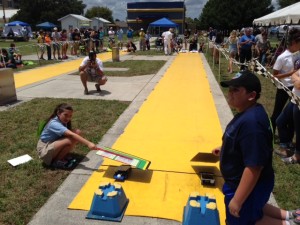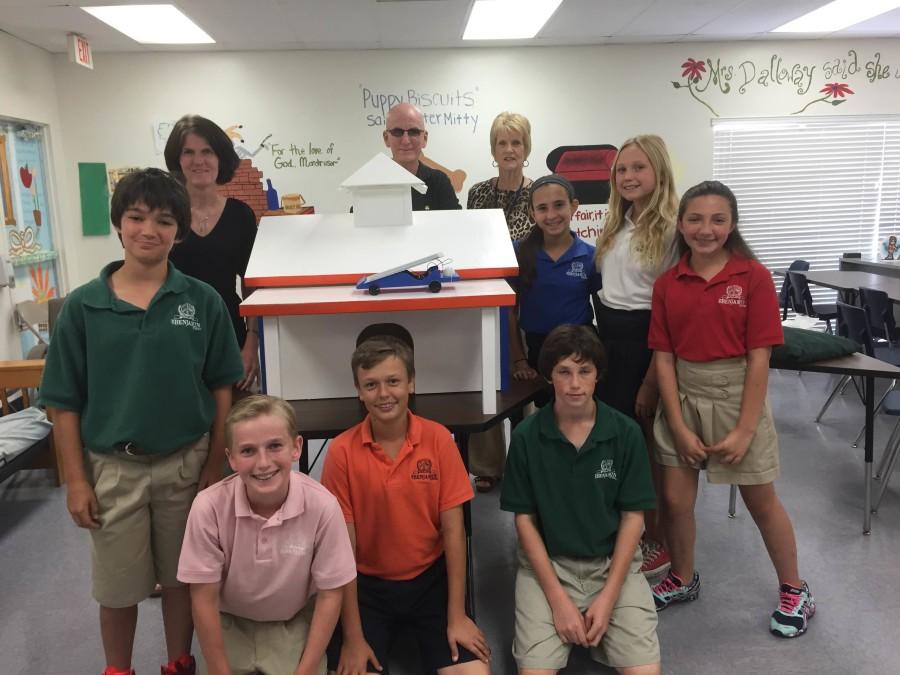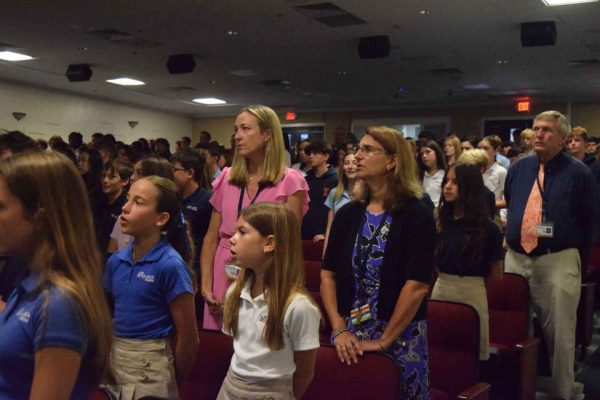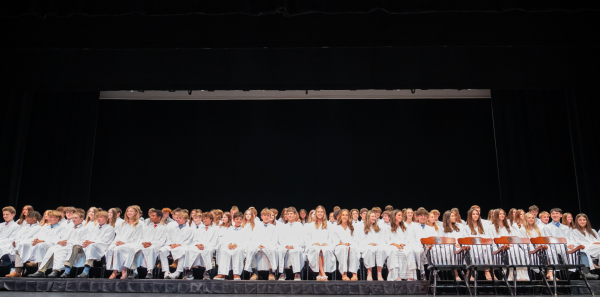The Green Machine
Mr. Bruce Duncan led a team of sixth graders as it competed for the first time at the Energy Whiz Olympics.
The team surrounds the teacup pig habitat and solar-powered car which it entered into the competition. The club consisted of (clockwise from center) Mr. Duncan (advisor), Mrs. Duncan (advisor), Emma Shirzad, Ebba Kihlberg, Chloe Habib, Chase Shapiro, Cade Odom, Robin Howley, Andrew Schwartz, and Mrs. Labzda (advisor).
On May 2, a small group of middle school students comprised of sixth graders Chloe Habib, Robin Howley, Ebba Kihlberg, Cade Odom, Andrew Schwartz, Chase Shapiro, and Emma Shirzad made their way to Cocoa Beach for the Energy Whiz Olympics. This competition began in 1999, but this is the first time our School has ever attended. The students who competed are all members of The Benjamin School Green Club.
The TBS Green Club started because Mr. Duncan, the husband of Mrs. Duncan, the lower/middle school librarian, very kindly offered to begin this club at Benjamin. Mr. Duncan is also a Florida-licensed residential contractor and a state-licensed solar contractor. On the first day of the club, Mr. Duncan gave each member a mission statement which stated, “We seek to create livability through innovative and thought-provoking human scale, usable and sustainable designs.” In other words, the main goal of the club is to create inventions that humans need which are solar powered and do not risk draining the environment of human resources. The mission statement also stated that the club “seeks to explore the limits of human interaction with the natural environment.” The students, rather than feeling daunted by this mission statement, were all ready to embrace its challenge.
Mr. Duncan’s goal for the club this year was one that he and his students attained this past Saturday, May 2 when they went to the Energy Whiz Olympics. “The Energy Whiz Olympics, held at the Florida Solar Energy Center in Cocoa Beach, has the goal of teaching alternative sources of energy and sustainable design through competition,” explained Mr. Duncan. He also explained that “The Benjamin Green Club …entered the Comfort Critter Cottage and the Junior Solar Sprint [portions of the competition].” Mrs. Duncan explained that, “the competition you are put in at the olympics is based on your grade level. The higher your grade, the more advanced the projects are. We are in the sixth-eighth grade competition.” Every group that joins this competitions has to build a solar-powered mini car and a solar-powered environmental habitat that is suitable for an animal. “We have four students that built the Comfort Critter Cottage and three who built the car,” explained Mrs. Duncan.

Chloe Habib gets ready to race the team’s car in one of the heats at the Florida Solar Energy Center.
The students who built the car were judged on design, and the cars raced head-to-head elimination style. The car and the habitat were built from scratch, but there were some guidelines for what they could and could not do. The car could not be too large and take up too much space on the race track because it might interfere with the other cars. The habitat also could not be too large for a display table, but both projects could be decorated any way that the group wanted to decorate them.
In the Comfort Critter Cottage Competition, the students needed to build a solar powered habitat that was suitable for an animal, which was picked by the group. But, before they could pick their animal, they needed to build a strong environment in which any animal could survive. “The house that we constructed is made out of SIPS, which is a structural insulated paneling system. We used it because it is stable, and it does not allow the inside of the house to get too hot,” said Emma Shirzad, one of the four club members working on the house. Once they finished the construction, they chose their animal. “The club chose the Teacup Pig as its critter,” Mrs. Duncan explained. The students thus needed to make a habitat that a teacup pig could live in and make it creative for design points from the judges.
The Junior Solar Sprint Competition, “is a design and race competition for solar electric powered cars,” said Mr. Duncan. Chase Shapiro, one of the members working on the car, said, “The car we have designed is made out of balsa wood. And to make the car move, we had to put together a series of equations, called gear functions, so that the wheels of the car would move under the power of the sun.”
Even though these projects seem easy as they are explained, they cannot be done overnight. The students needed time to work on their projects, which is why, every other Friday during club time, this green group worked on perfecting its craft.
“On Fridays during the first half of the year the club explored such things as becoming energy conscious, a process of understanding the basis of where our various sources of energy come from and how they are incorporated into the designs we create,” Mr. Duncan commented. Then, after the students learned about the basis of solar energy and different designs, they started to build the cars and habitats for the competition.
Many hours of preparation were put into these projects. Sometimes, when the students did not have club time during the school week, they went to Mr. Duncan’s garage in his house and worked on Saturdays, where they also had a lot of fun. “We had the opportunity to work on three Saturdays at our house where the students got a lot done. This is where they did most of the building and designing for the house and the car,” stated Mrs. Duncan.
The day of the competition was very nerveracking for everybody entered in the contest. “It was very crowded, but it was really interesting to see everybody’s projects compared to ours,” explained Mrs. Duncan. “We did really well for our first showing,” Mrs. Duncan also stated. “The car won three out of the four races entered and won a prize, and the house, sadly, did not win anything.” The club had a great showing at their first Energy Whiz Olympics, and the three students who built the car won the award for the best design. Hopefully, the middle school Green Club can continue to go to the Olympics and go for the gold! The Benjamin School and The Green Club are so proud of the Duncan’s team and so grateful to them for their long hours of selfless work to provide this once in a lifetime experience for our students. Thank you, Mr. and Mrs. Duncan and members of the Green Club!





